Natural Rubber Blend Optimization via Data-Driven Modeling: The Implementation for Reverse Engineering
Abstract
1. Introduction
2. Materials and Methods
2.1. Materials and Blending
2.2. Material Characterization
2.2.1. Rheological Characterization
2.2.2. Lissajous Curve Characterization
2.2.3. Relaxation Curve Characterization
2.2.4. Sample Morphology Characterization
2.2.5. Durometer Characterization
2.3. Computational Methods for Predictive Models
2.3.1. Linear Regression Implementation
2.3.2. Response Surface Method Implementation
2.3.3. Artificial Neural Network Algorithm Development
2.3.4. Gaussian Process Regression Algorithm Development
3. Results and Discussion
3.1. Material Characterization
3.1.1. Influence of Voids on Viscoelastic and Static Properties
3.1.2. Influence of Sulfur on Viscoelastic and Static Properties
3.1.3. Influence of Paraffin Oil on Viscoelastic and Static Properties
3.2. Predictive Methodologies for Reverse Engineering
3.2.1. Response Surface Method Prediction Results
3.2.2. Artificial Neural Network Prediction Results
3.2.3. Gaussian Process Regression Prediction Results
3.3. Material Design Optimization
4. Conclusions
Author Contributions
Funding
Institutional Review Board Statement
Informed Consent Statement
Data Availability Statement
Conflicts of Interest
References
- Morton, M. History of Synthetic Rubber. J. Macromol. Sci. Part A—Chem. 1981, 15, 1289–1302. [Google Scholar] [CrossRef]
- Fisher, J.C.; Pry, R.H. A simple substitution model of technological change. Technol. Forecast. Soc. Chang. 1971, 3, 75–88. [Google Scholar] [CrossRef]
- Ren, X.; Barrera, C.S.; Tardiff, J.L.; Gil, A.; Cornish, K. Liquid guayule natural rubber, a renewable and crosslinkable processing aid in natural and synthetic rubber compounds. J. Clean. Prod. 2020, 276, 122933. [Google Scholar] [CrossRef]
- Cornish, K. Alternative Natural Rubber Crops: Why Should We Care? Technol. Innov. 2017, 18, 244–255. [Google Scholar] [CrossRef]
- Poh, G.K.X.; Chew, I.M.L.; Tan, J. Life Cycle Optimization for Synthetic Rubber Glove Manufacturing. Chem. Eng. Technol. 2019, 42, 1771–1779. [Google Scholar] [CrossRef]
- Gunathilaka, L.F.D.Z.; Gunawardana, K.D. Carbon Footprint Calculation from Cradle to Grave: A Case Study of Rubber Manufacturing Process in Sri Lanka. Int. J. Bus. Soc. Sci. 2015, 6, 82–94. [Google Scholar]
- Jacob, J.L.; d’Auzac, J.; Prevôt, J.C. The composition of natural latex from Hevea brasiliensis. Clin. Rev. Allergy 1993, 11, 325–337. [Google Scholar] [CrossRef]
- Jayanthy, T.; Sankaranarayanan, P.E. Measurement of Dry Rubber Content in Latex Using Microwave Technique. Meas. Sci. Rev. 2005, 5, 50–54. [Google Scholar]
- Sansatsadeekul, J.; Sakdapipanich, J.; Rojruthai, P. Characterization of associated proteins and phospholipids in natural rubber latex. J. Biosci. Bioeng. 2011, 111, 628–634. [Google Scholar] [CrossRef]
- Salomez, M.; Subileau, M.; Intapun, J.; Bonfils, F.; Sainte-Beuve, J.; Vaysse, L.; Dubreucq, E. Micro-organisms in latex and natural rubber coagula of Hevea brasiliensis and their impact on rubber composition, structure and properties. J. Appl. Microbiol. 2014, 117, 921–929. [Google Scholar] [CrossRef]
- Zhao, F.; Bi, W.; Zhao, S. Influence of Crosslink Density on Mechanical Properties of Natural Rubber Vulcanizates. J. Macromol. Sci. Part B 2011, 50, 1460–1469. [Google Scholar] [CrossRef]
- Sombatsompop, N. Analysis of Cure Characteristics on Cross-Link Density and Type, and Viscoelastic Properties of Natural Rubber. Polym. Plast. Technol. Eng. 1998, 37, 333–349. [Google Scholar] [CrossRef]
- Klüppel, M.; Heinrich, G. Network Structure and Mechanical Properties of Sulfur-Cured Rubbers. Macromolecules 1994, 27, 3596–3603. [Google Scholar] [CrossRef]
- Dasgupta, S.; Agrawal, S.L.; Bandyopadhyay, S.; Chakraborty, S.; Mukhopadhyay, R.; Malkani, R.K.; Ameta, S.C. Characterisation of eco-friendly processing aids for rubber compound: Part II. Polym. Test. 2008, 27, 277–283. [Google Scholar] [CrossRef]
- Raju, P.; Nandanan, V.; Kutty, S.K.N. A Study on the Use of Castor Oil as Plasticizer in Natural Rubber Compounds. Prog. Rubber Plast. Recycl. Technol. 2007, 23, 169–180. [Google Scholar] [CrossRef]
- Nakason, C.; Saiwaree, S.; Tatun, S.; Kaesaman, A. Rheological, thermal and morphological properties of maleated natural rubber and its reactive blending with poly(methyl methacrylate). Polym. Test. 2006, 25, 656–667. [Google Scholar] [CrossRef]
- Pechurai, W.; Muansupan, T.; Seawlee, P. Effect of foaming temperature and blowing agent content on cure characteristics, mechanical and morphological properties of natural rubber foams. Adv. Mater. Res. 2014, 844, 454–457. [Google Scholar] [CrossRef]
- Najib, N.N.; Ariff, Z.M.; Bakar, A.A.; Sipaut, C.S. Correlation between the acoustic and dynamic mechanical properties of natural rubber foam: Effect of foaming temperature. Mater. Des. 2011, 32, 505–511. [Google Scholar] [CrossRef]
- Zauzi, N.S.A.; Ariff, Z.M.; Khimi, S.R. Foamability of natural rubber via microwave assisted foaming with azodicarbonamide (ADC) as blowing agent. Mater. Today Proc. 2019, 17, 1001–1007. [Google Scholar] [CrossRef]
- Shimbo, M.; Baldwin, D.F.; Suh, N.P. The viscoelastic behavior of microcellular plastics with varying cell size. Polym. Eng. Sci. 1995, 35, 1387–1393. [Google Scholar] [CrossRef]
- Liao, X.; Xu, H.; Li, S.; Zhou, C.; Li, G.; Park, C.B. The effects of viscoelastic properties on the cellular morphology of silicone rubber foams generated by supercritical carbon dioxide. RSC Adv. 2015, 5, 106981–106988. [Google Scholar] [CrossRef]
- Capote, G.A.M.; Oehlmann, P.E.V.; Campos, J.C.B.; Hegge, G.R.; Osswald, T.A. Trends in force and print speed in Material Extrusion. Addit. Manuf. 2021, 46, 102141. [Google Scholar] [CrossRef]
- Oehlmann, P.; Osswald, P.; Blanco, J.C.; Friedrich, M.; Rietzel, D.; Witt, G. Modeling Fused Filament Fabrication using Artificial Neural Networks. Prod. Eng. 2021, 15, 467–478. [Google Scholar] [CrossRef]
- Román, A.J.; Qin, S.; Zavala, V.M.; Osswald, T.A. Neural network feature and architecture optimization for injection molding surface defect prediction of model polypropylene. Polym. Eng. Sci. 2021, 61, 2376–2387. [Google Scholar] [CrossRef]
- Lockner, Y.; Hopmann, C. Induced network-based transfer learning in injection molding for process modelling and optimization with artificial neural networks. Int. J. Adv. Manuf. Technol. 2021, 112, 3501–3513. [Google Scholar] [CrossRef]
- Tercan, H.; Guajardo, A.; Heinisch, J.; Thiele, T.; Hopmann, C.; Meisen, T. Transfer-Learning: Bridging the Gap between Real and Simulation Data for Machine Learning in Injection Molding. Procedia CIRP 2018, 72, 185–190. [Google Scholar] [CrossRef]
- Kopal, I.; Harničárová, M.; Valíček, J.; Kušnerová, M. Modeling the temperature dependence of dynamic mechanical properties and visco-elastic behavior of thermoplastic polyurethane using artificial neural network. Polymers 2017, 9, 519. [Google Scholar] [CrossRef]
- Capote, G.A.M. Predicting Mechanical Properties of Fused Filament Fabrication Parts. Ph.D. Thesis, University of Wisconsin-Madison, Madison, WI, USA, 2021. [Google Scholar]
- Thomas, A.J.; Barocio, E.; Pipes, R.B. A machine learning approach to determine the elastic properties of printed fiber-reinforced polymers. Compos. Sci. Technol. 2022, 220, 109293. [Google Scholar] [CrossRef]
- Xu, X. Machine Learning Approach to Characterize Elastic, Viscoelastic, Relaxation and Creep Behavior of Materials. Ph.D. Thesis, New York University, New York, NY, USA, 2020. [Google Scholar]
- Osswald, T.A.; Rudolph, N.M. Polymer Rheology; Hanser Publishers: Munich, Germany, 2015. [Google Scholar]
- Ferry, J.D. Viscoelastic Properties of Polymers; Wiley: Chichester, UK, 1980. [Google Scholar]
- Lakes, R. Viscoelastic Materials; Cambridge University Press: Cambridge, UK, 2009. [Google Scholar]
- Thornton, G.M.; Frank, C.B.; Shrive, N.G. Ligament creep behavior can be predicted from stress relaxation by incorporating fiber recruitment. J. Rheol. 2001, 45, 493–507. [Google Scholar] [CrossRef]
- Koeller, R.C. A theory relating creep and relaxation for linear materials with memory. J. Appl. Mech. Trans. ASME 2010, 77, 031008. [Google Scholar] [CrossRef]
- Kane, R.J.; Converse, G.L.; Roeder, R.K. Effects of the reinforcement morphology on the fatigue properties of hydroxyapatite reinforced polymers. J. Mech. Behav. Biomed. Mater. 2008, 1, 261–268. [Google Scholar] [CrossRef] [PubMed][Green Version]
- Eslami, S.; Tavares, P.J.; Moreira, P.M.G.P. Fatigue Life Assessment of Friction Stir welded Dissimilar Polymers. Procedia Struct. Integr. 2017, 5, 1433–1438. [Google Scholar] [CrossRef]
- Lee, J.K.; Han, C.D. Evolution of polymer blend morphology during compounding in an internal mixer. Polymer 1999, 40, 6277–6296. [Google Scholar] [CrossRef]
- Fitzka, M.; Schönbauer, B.M.; Rhein, R.K.; Sanaei, N.; Zekriardehani, S.; Tekalur, S.A.; Carroll, J.W.; Mayer, H. Usability of ultrasonic frequency testing for rapid generation of high and very high cycle fatigue data. Materials 2021, 14, 2245. [Google Scholar] [CrossRef] [PubMed]
- Hooper, J.M.; Marco, J. Understanding vibration frequencies experienced by electric vehicle batteries. IET Conf. Publ. 2013, 2013, 1–6. [Google Scholar] [CrossRef]
- Mora, E.; Artavia, L.D.; Macosko, C.W. Modulus development during reactive urethane foaming. J. Rheol. 1991, 35, 921–940. [Google Scholar] [CrossRef]
- Park, J.; Siegmund, T.; Mongeau, L. Viscoelastic Properties of Foamed Thermoplastic Vulcanizates and their Dependence on Void Fraction. Cell. Polym. 2003, 22, 137–156. [Google Scholar] [CrossRef]
- Shi, S.; Liang, J. Thermal Decomposition Behavior of Silica-Phenolic Composite Exposed to One-Sided Radiant Heating. Polym. Polym. Compos. 2008, 16, 101–113. [Google Scholar] [CrossRef]
- Ismail, H.; Freakley, P.K.; Sutherland, I.; Sheng, E. Effects of multifunctional additive on mechanical properties of silica filled natural rubber compound. Eur. Polym. J. 1995, 31, 1109–1117. [Google Scholar] [CrossRef]
- Nasruddin, N.; Susanto, T. Study of the mechanical properties of natural rubber composites with synthetic rubber using used cooking oil as a softener. Indones. J. Chem. 2020, 20, 967–978. [Google Scholar] [CrossRef]
- Lin, Y.; Chen, Y.; Zeng, Z.; Zhu, J.; Wei, Y.; Li, F.; Liu, L. Effect of ZnO nanoparticles doped graphene on static and dynamic mechanical properties of natural rubber composites. Compos. Part A Appl. Sci. Manuf. 2015, 70, 35–44. [Google Scholar] [CrossRef]
- Jacob, M.; Thomas, S.; Varughese, K.T. Mechanical Properties of Sisal/Oil Palm Hybrid Fiber Reinforced Natural Rubber Composites. Compos. Sci. Technol. 2004, 64, 955–965. [Google Scholar] [CrossRef]
- Osswald, T.A.; Menges, G. Material Science of Polymers for Engineers; Hanser Publishers: Cincinnati, OH, USA, 2012. [Google Scholar]
- Baur, E.; Osswald, T.A.; Rudolph, N.S. Plastics Handbook: The Resource for Plastics Engineers; Hanser Publishers: Munich, Germany, 2019. [Google Scholar]
- Goodfellow, I.; Bengio, Y.; Courville, A. Deep Learning; MIT Press: Cambridge, UK, 2019. [Google Scholar]
- Pedregosa, F.; Varoquaux, G.; Gramfort, A.; Michel, V.; Thirion, B.; Grisel, O.; Blondel, M.; Prettenhofer, P.; Weiss, R.; Dubourg, V.; et al. Scikit-learn: Machine Learning in Python. J. Mach. Learn. Res. 2011, 12, 2825–2830. [Google Scholar]
- El Magri, A.; El Mabrouk, K.; Vaudreuil, S.; Touhami, M.E. Experimental investigation and optimization of printing parameters of 3D printed polyphenylene sulfide through response surface methodology. J. Appl. Polym. Sci. 2020, 138, 49625. [Google Scholar] [CrossRef]
- Waseem, M.; Salah, B.; Habib, T.; Saleem, W.; Abas, M.; Khan, R.; Ghani, U.; Siddiqi, M.U.R. Multi-response optimization of tensile creep behavior of PLA 3D printed parts using categorical response surface methodology. Polymers 2020, 12, 2962. [Google Scholar] [CrossRef]
- Srewaradachpisal, S.; Dechwayukul, C.; Chatpun, S.; Spontak, R.J.; Thongruang, W. Optimization of the rubber formulation for footwear applications from the response surface method. Polymers 2020, 12, 2032. [Google Scholar] [CrossRef]
- Coefficients Table for Analyze Response Surface Design. Minitab. Available online: https://support.minitab.com/en-us/minitab/18/help-and-how-to/modeling-statistics/doe/how-to/response-surface/analyze-response-surface-design/interpret-the-results/all-statistics-and-graphs/coefficients-table/ (accessed on 5 May 2022).
- Effects Plots for Analyze Response Surface Design. Minitab. Available online: https://support.minitab.com/en-us/minitab/18/help-and-how-to/modeling-statistics/doe/how-to/response-surface/analyze-response-surface-design/interpret-the-results/all-statistics-and-graphs/effects-plots/ (accessed on 5 May 2022).
- Abadi, M.; Agarwal, A.; Barham, P.; Brevdo, E.; Chen, Z.; Citro, C.; Corrado, G.S.; Davis, A.; Dean, J.; Devin, M.; et al. TensorFlow: Large-Scale machine learning on heterogeneous distributed systems. arXiv 2016, arXiv:1603.04467. [Google Scholar]
- Kingma, D.P.; Ba, J.L. Adam: A method for stochastic optimization. In Proceedings of the 3rd International Conference on Learning Representations, San Diego, CA, USA, 7–9 May 2015. [Google Scholar]
- Rasmussen, C.E. Gaussian Processes in machine learning. In Lecture Notes in Computer Science; Max Planck Institute for Biological Cybernetics: Tübingen, Germany, 2004; Volume 3176, pp. 63–71. [Google Scholar] [CrossRef]
- Osswald, T.A. Understanding Polymer Processing: Processes and Governing Equations; Hanser Publishers: Munich, Germany, 2018. [Google Scholar]
- Shen, J.; Lin, X.; Liu, J.; Li, X. Effects of Cross-Link Density and Distribution on Static and Dynamic Properties of Chemically Cross-Linked Polymers. Macromolecules 2019, 52, 121–134. [Google Scholar] [CrossRef]
- Fernandez, S.S.; Kunchandy, S.; Ghosh, S. Linseed Oil Plasticizer Based Natural Rubber/Expandable Graphite Vulcanizates: Synthesis and Characterizations. J. Polym. Environ. 2015, 23, 526–533. [Google Scholar] [CrossRef]
- Brochu, E.; Cora, V.M.; de Freitas, N. A tutorial on bayesian optimization of expensive cost functions, with application to active user modeling and hierarchical reinforcement learning. arXiv 2010, arXiv:1012.2599. [Google Scholar]
- Lu, Q.; González, L.D.; Kumar, R.; Zavala, V.M. Bayesian optimization with reference models: A case study in MPC for HVAC central plants. Comput. Chem. Eng. 2021, 154, 107491. [Google Scholar] [CrossRef]
- Virtanen, P.; Gommers, R.; Travis, E.O.; Haberland, M.; Reddy, T.; Cournapeau, D.; Burovski, E.; Peterson, P.; Weckesser, W.; Bright, J.; et al. SciPy 1.0: Fundamental algorithms for scientific computing in Python. Nat. Methods 2020, 17, 261–272. [Google Scholar] [CrossRef] [PubMed]
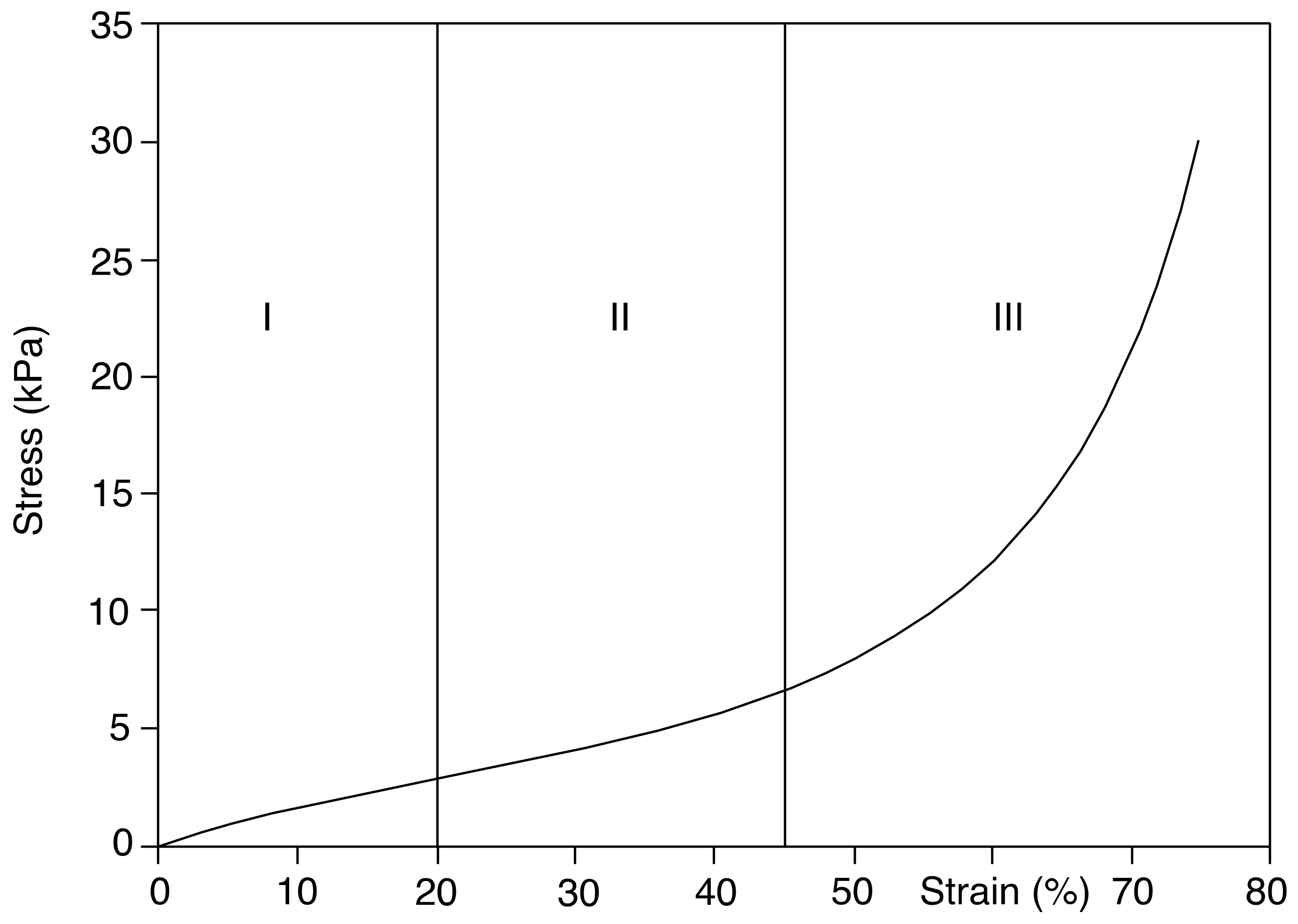

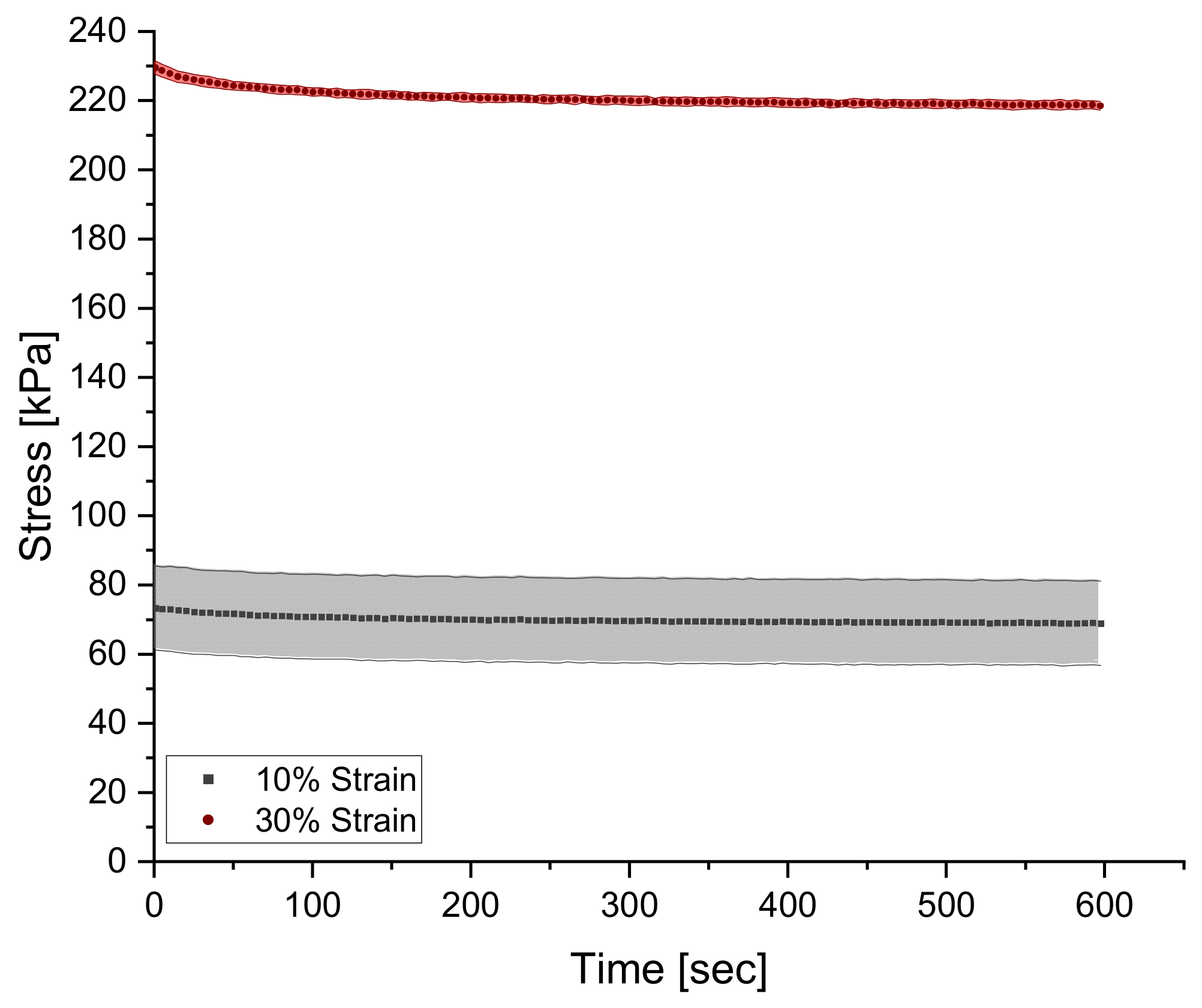
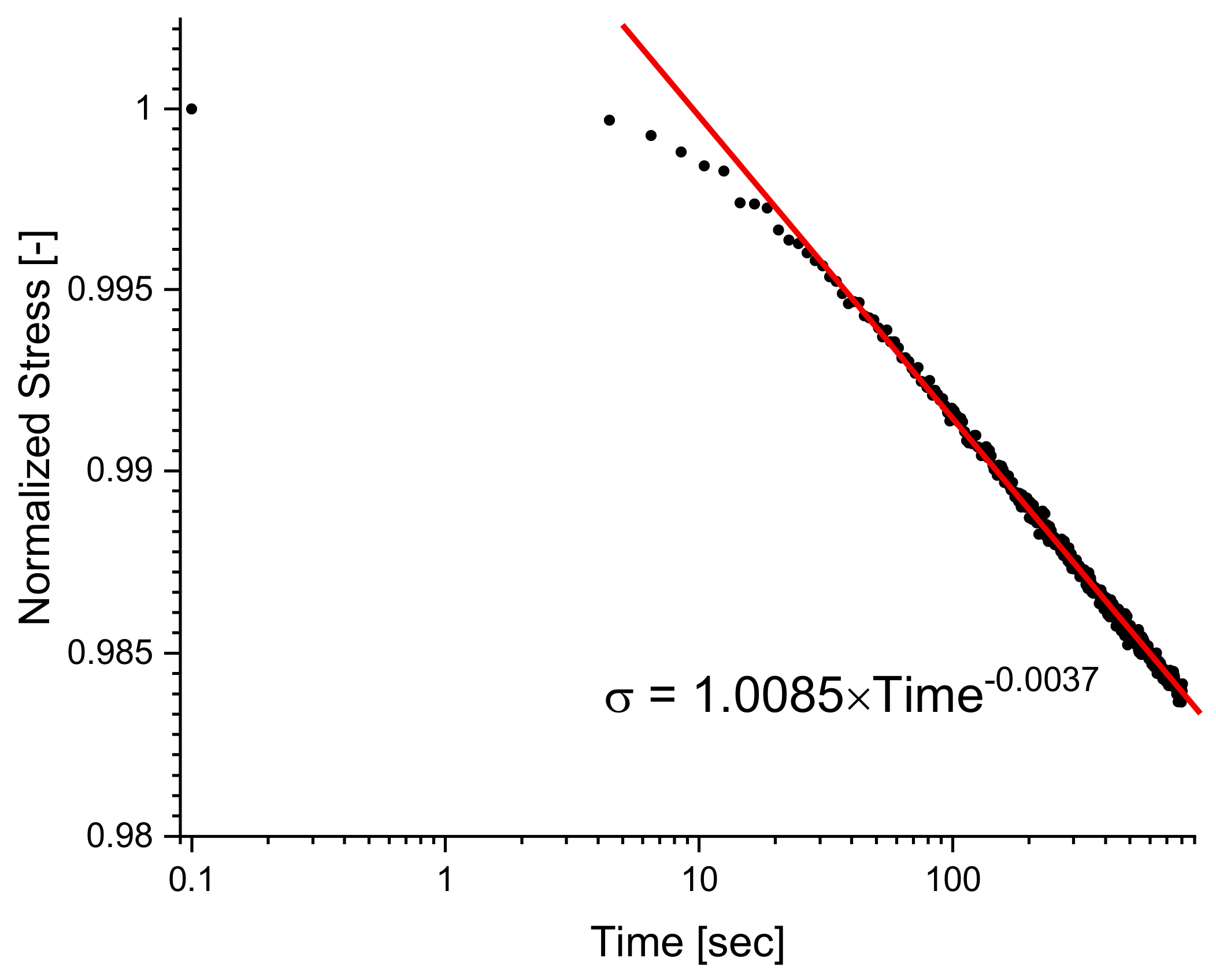



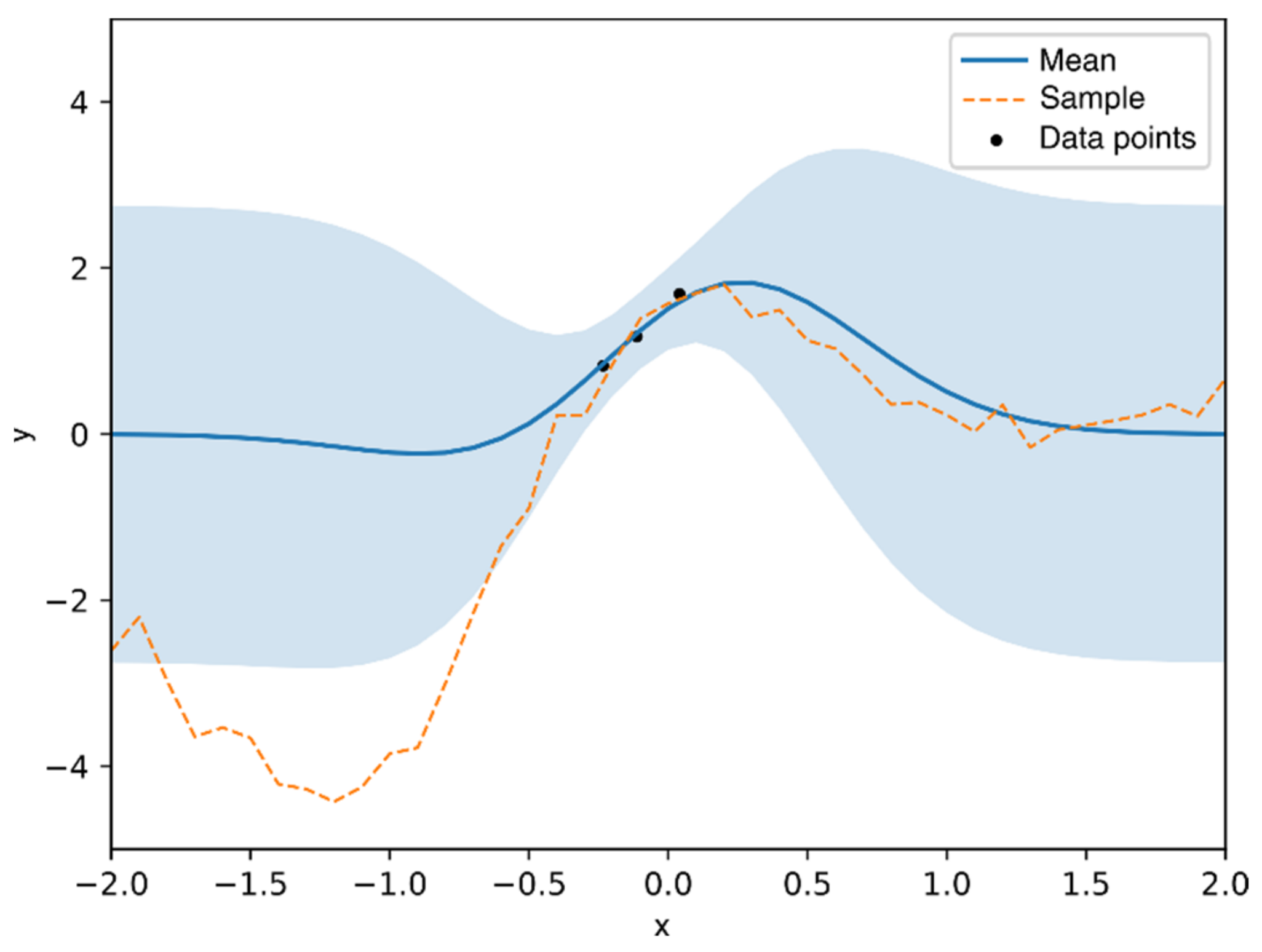


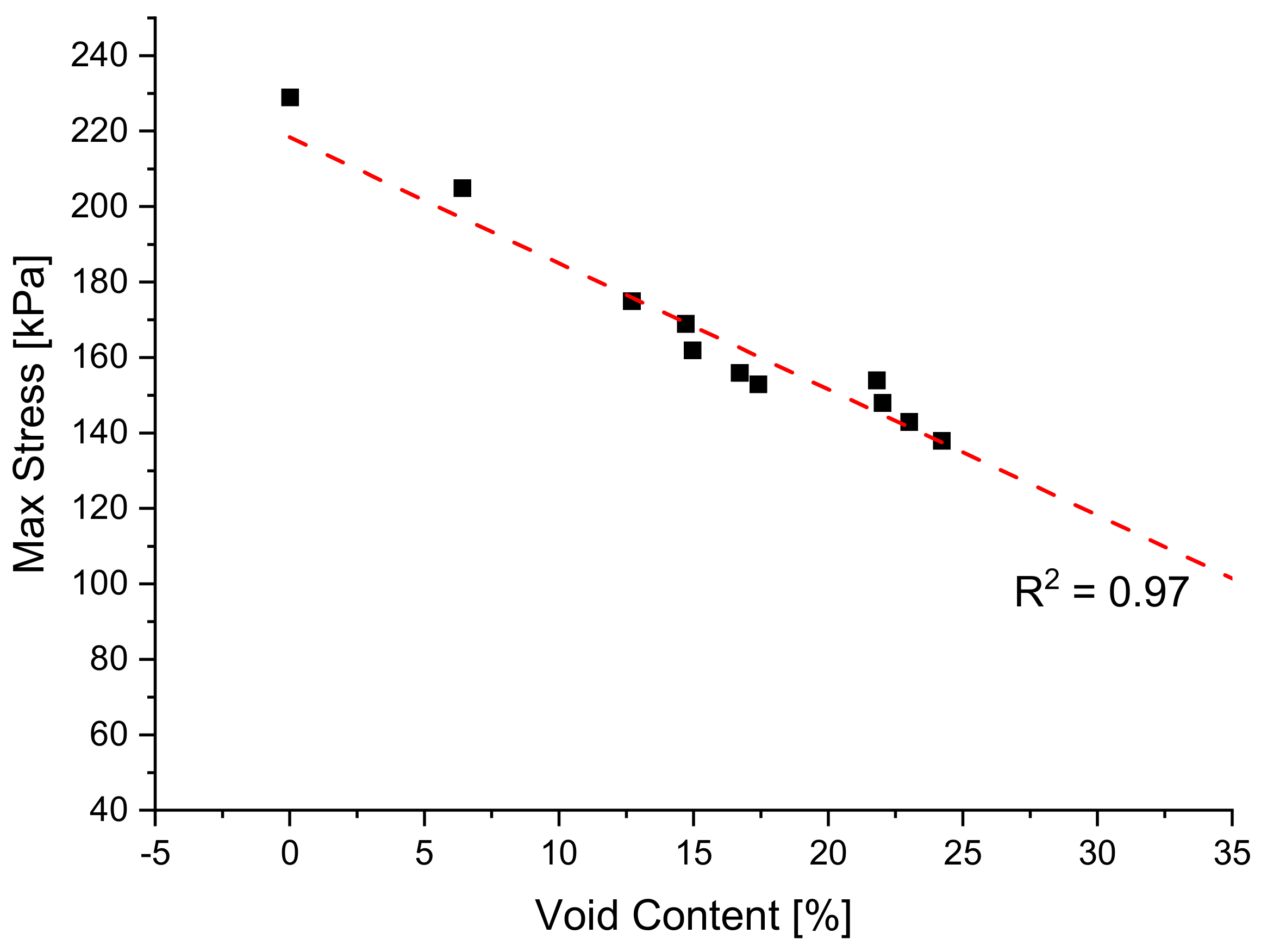
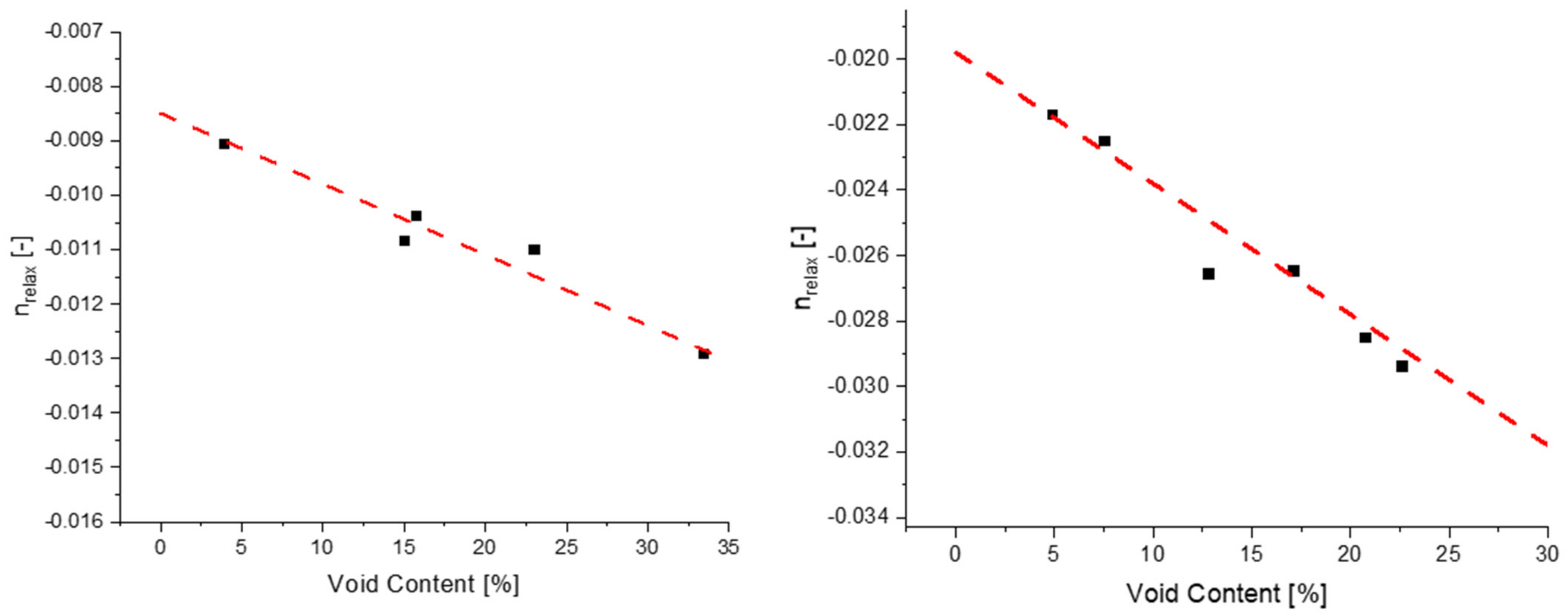
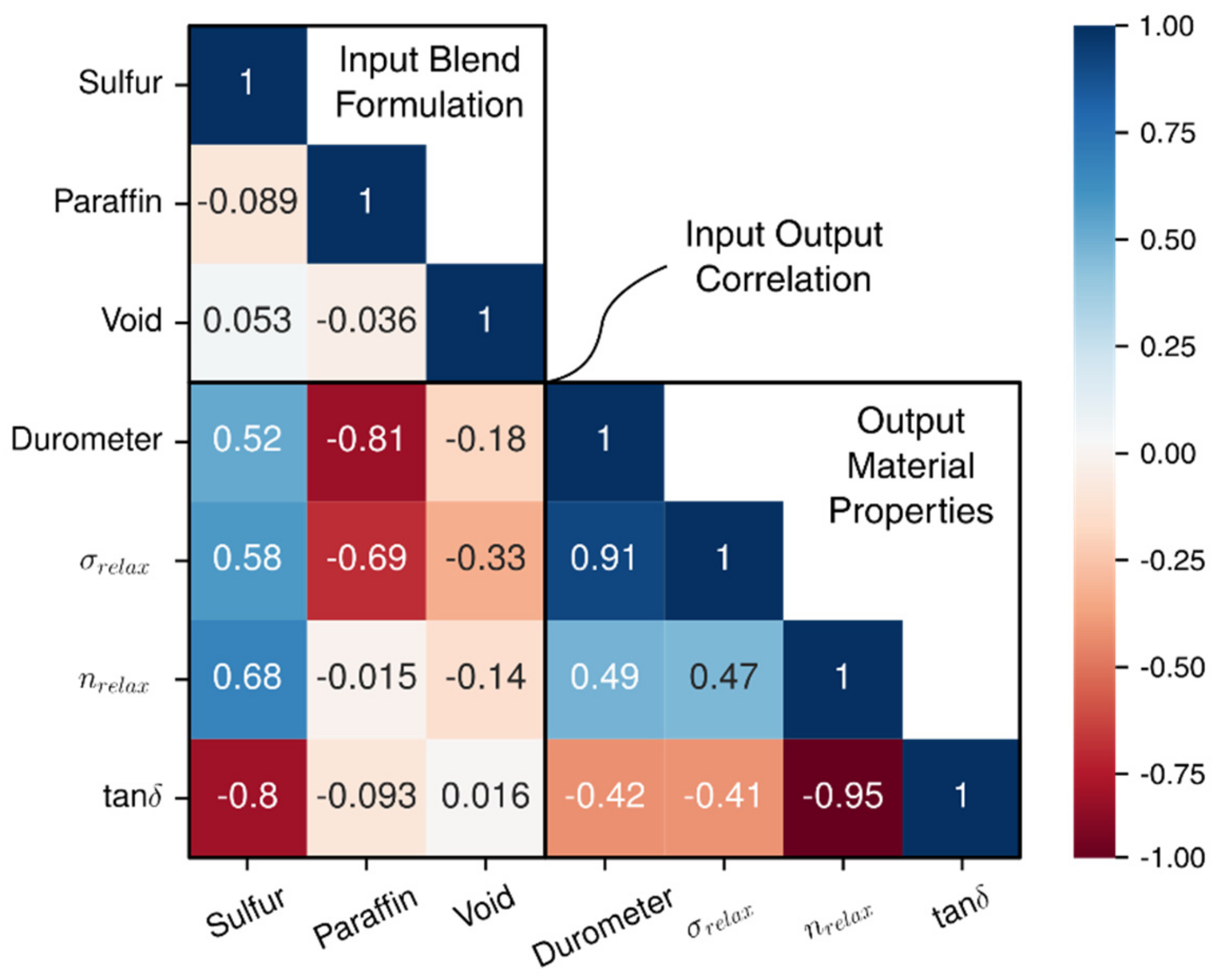
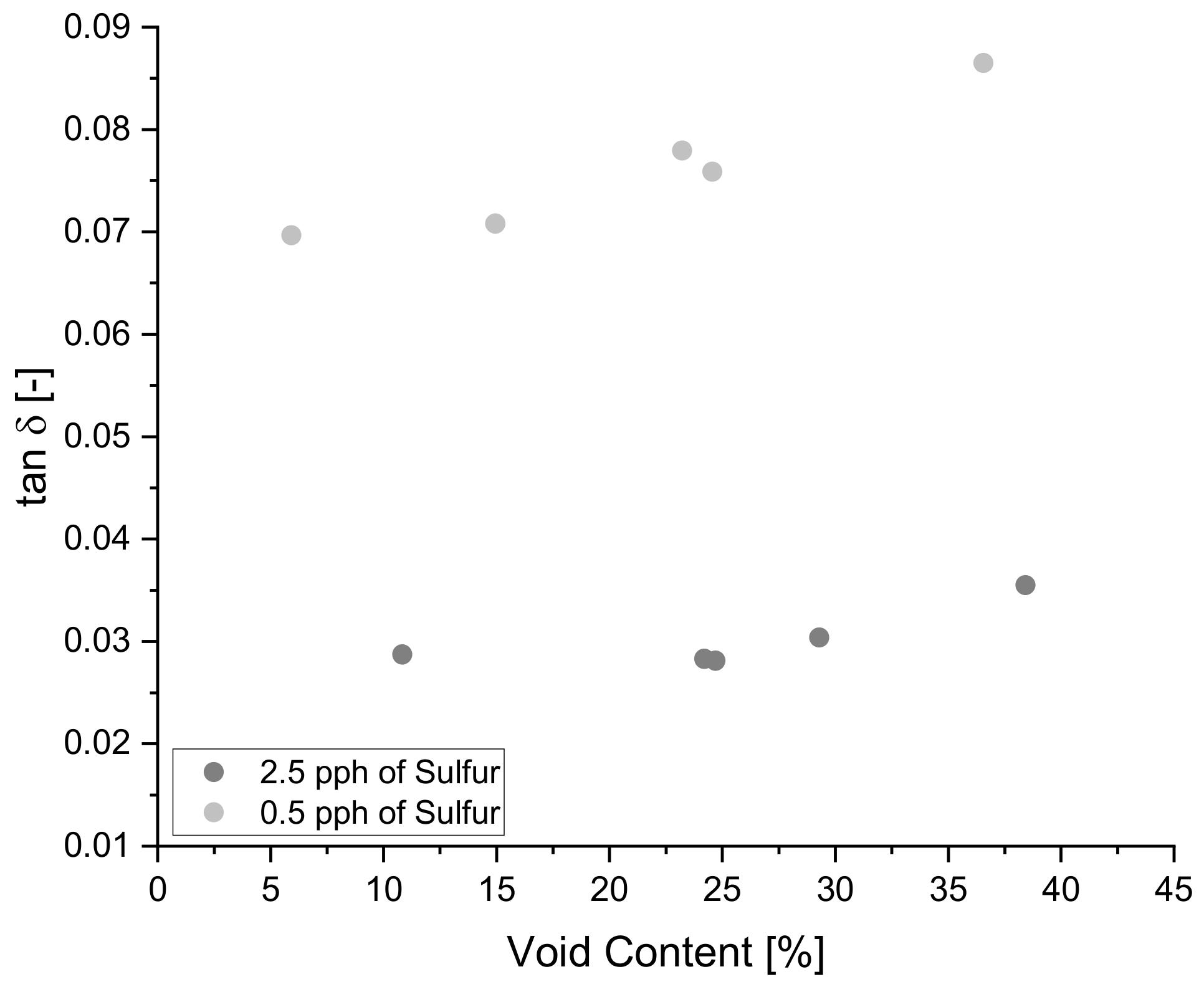

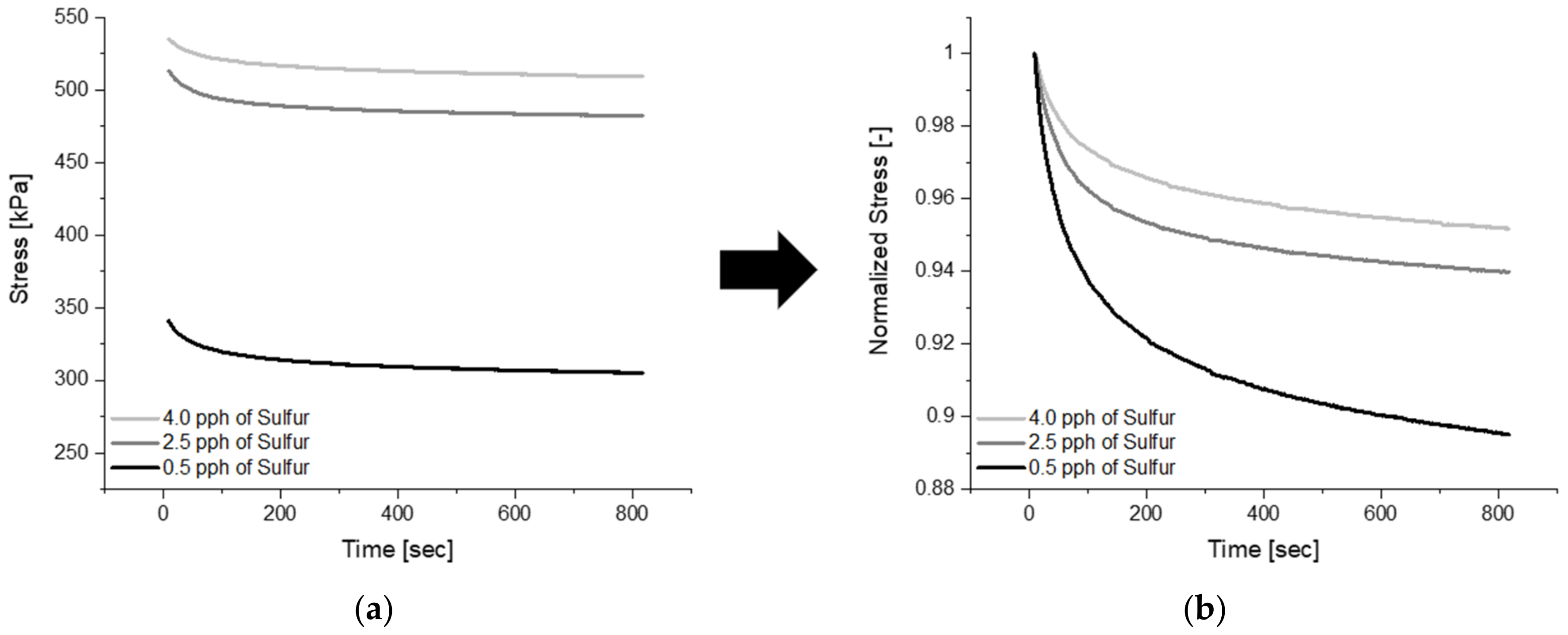
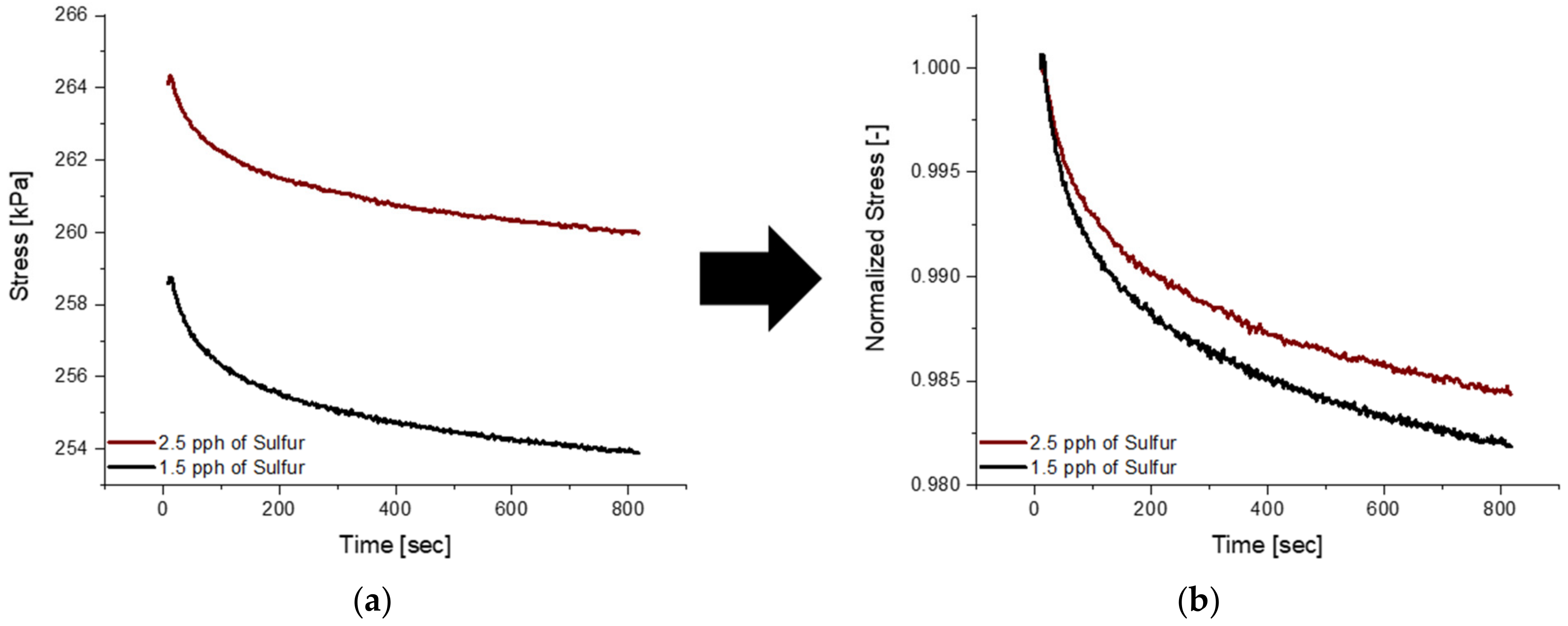
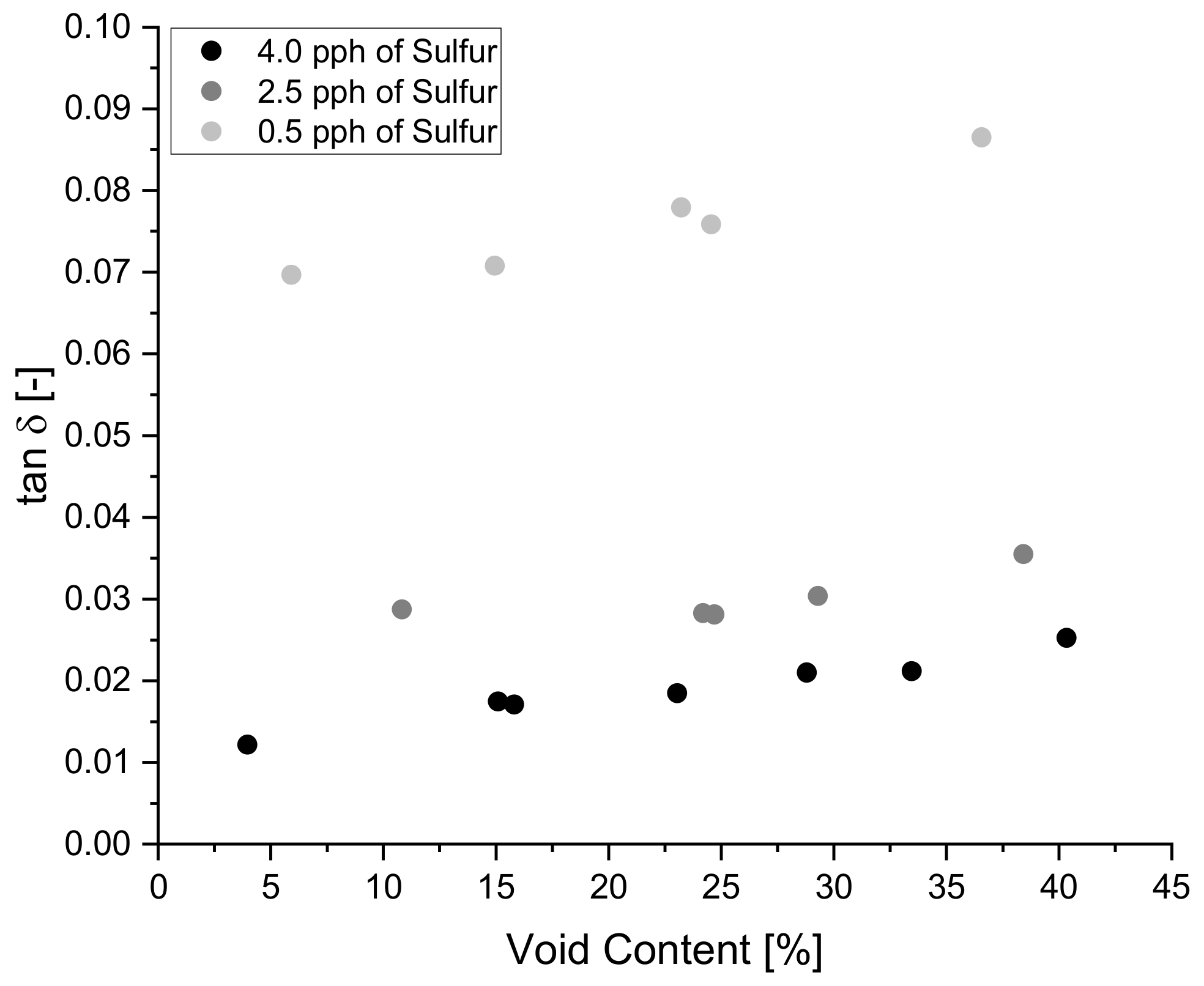
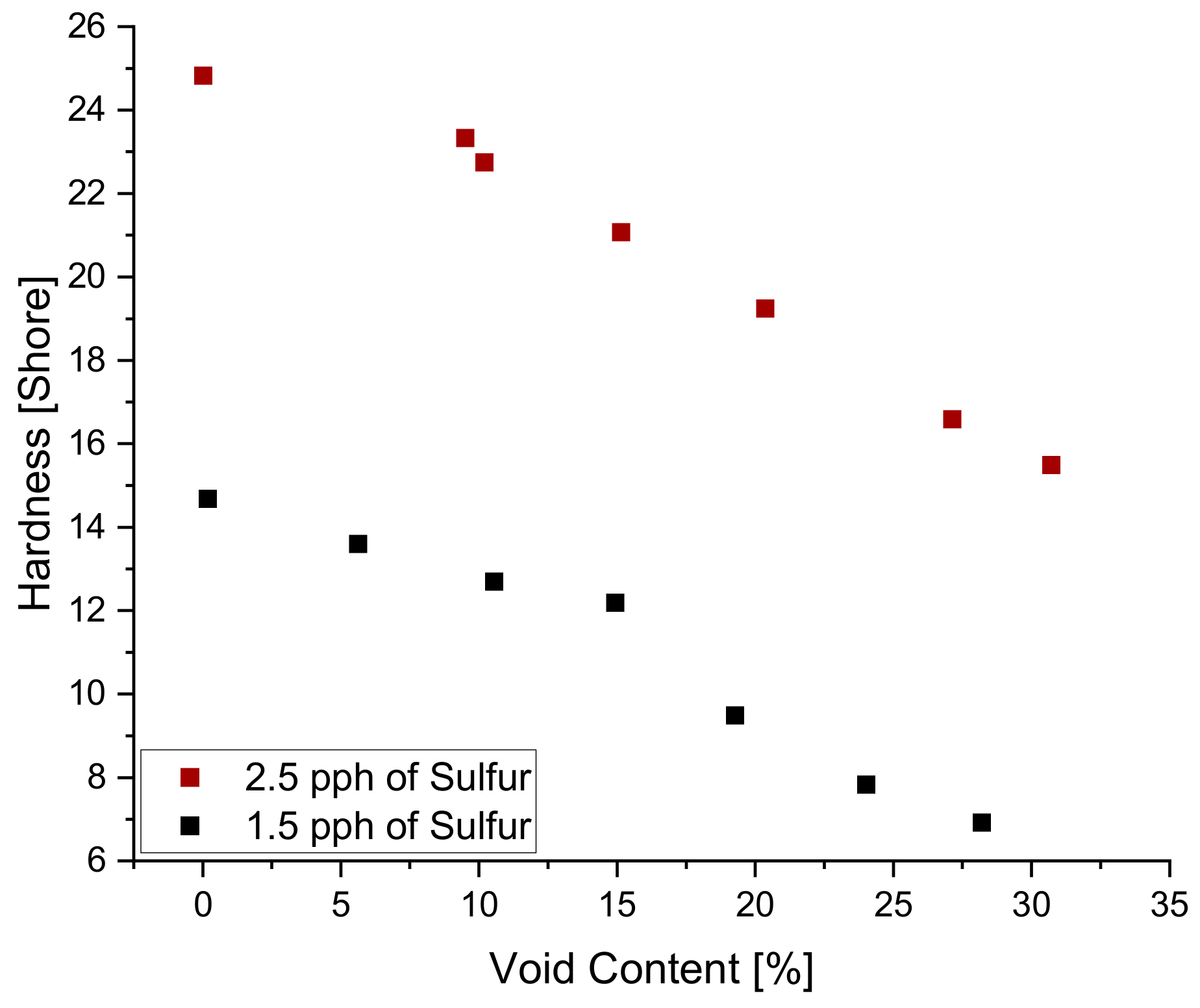
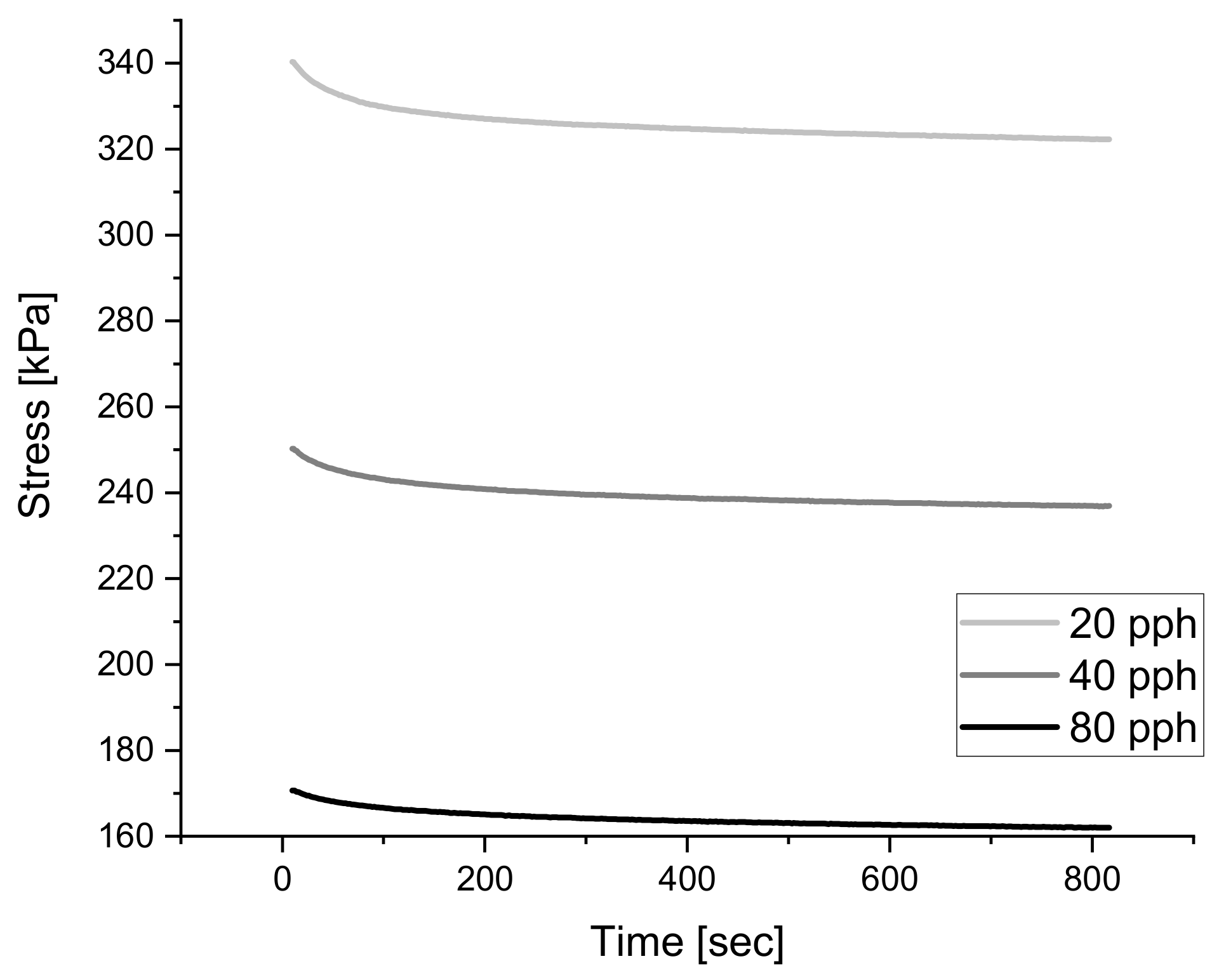

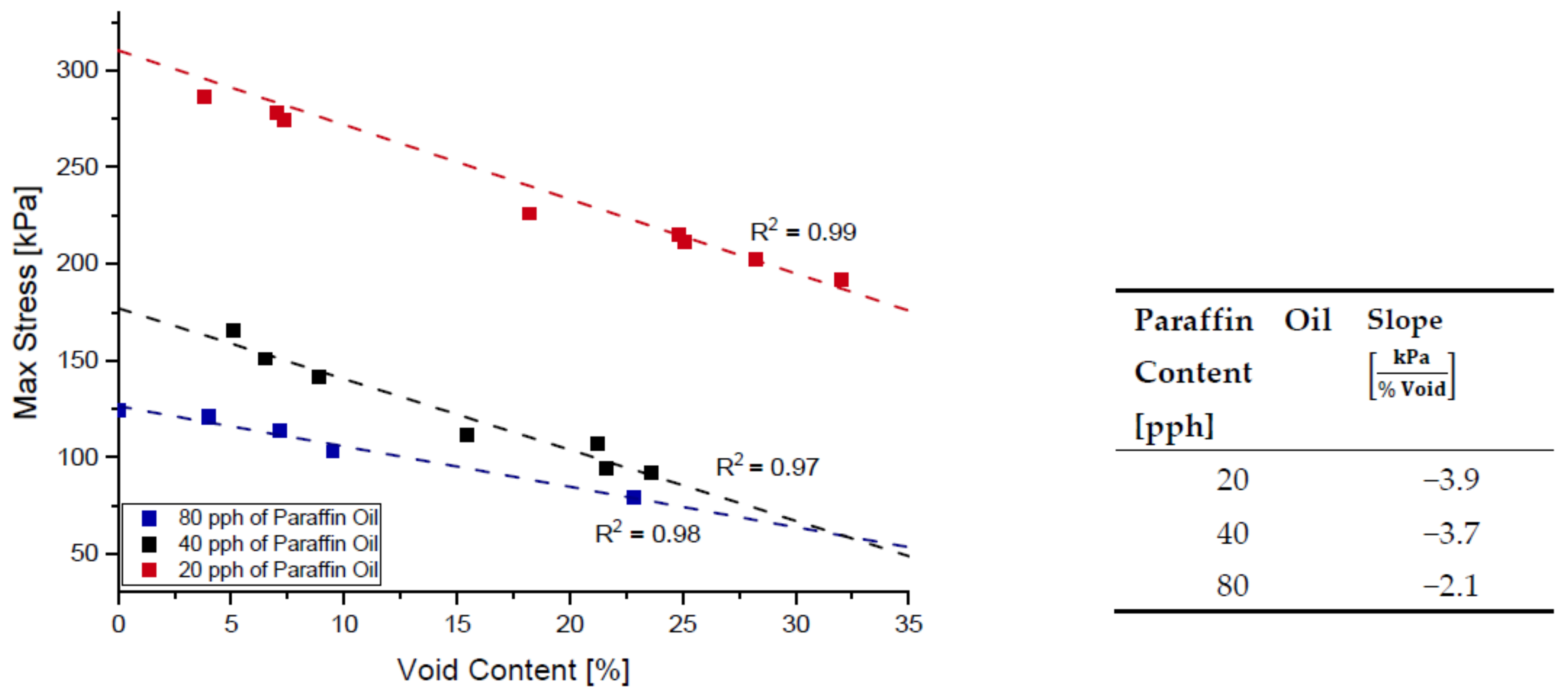
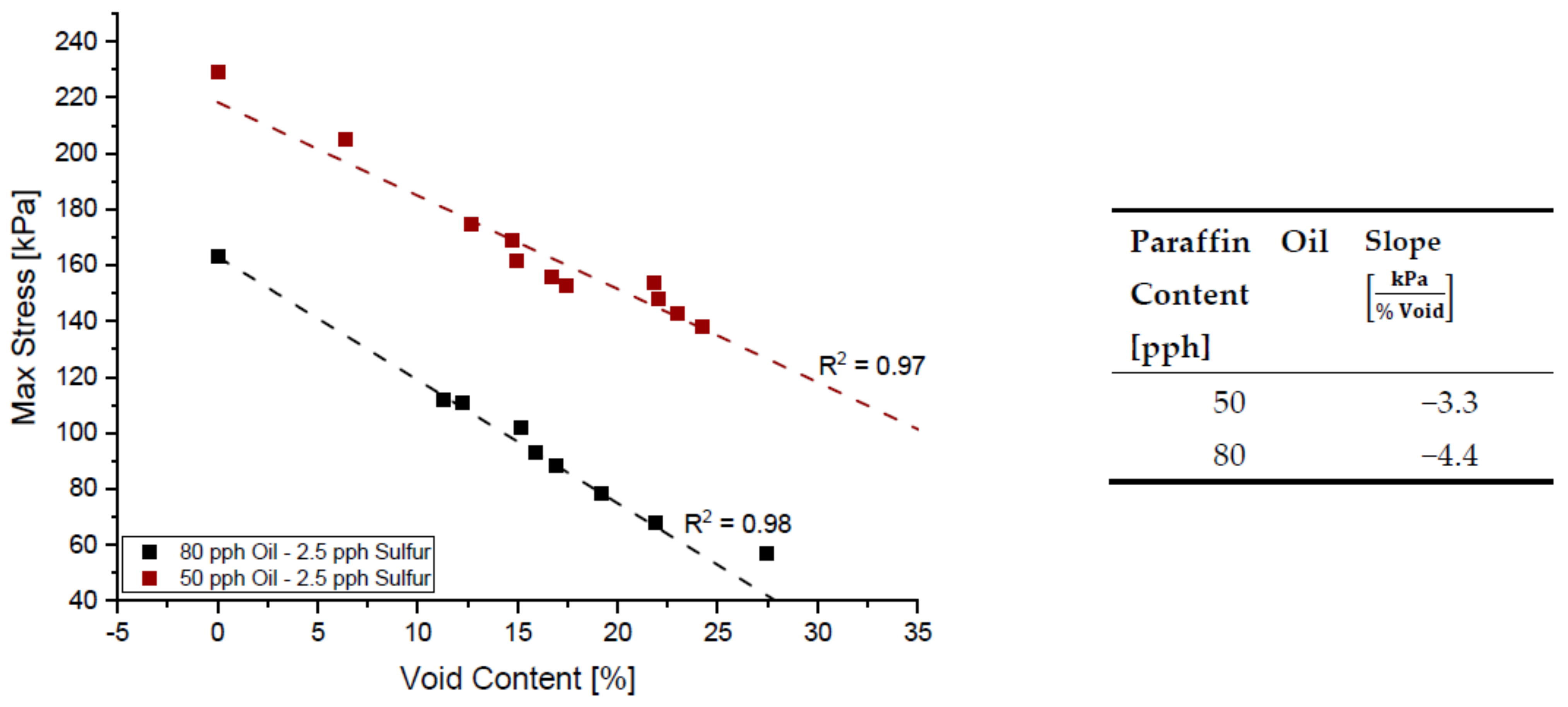
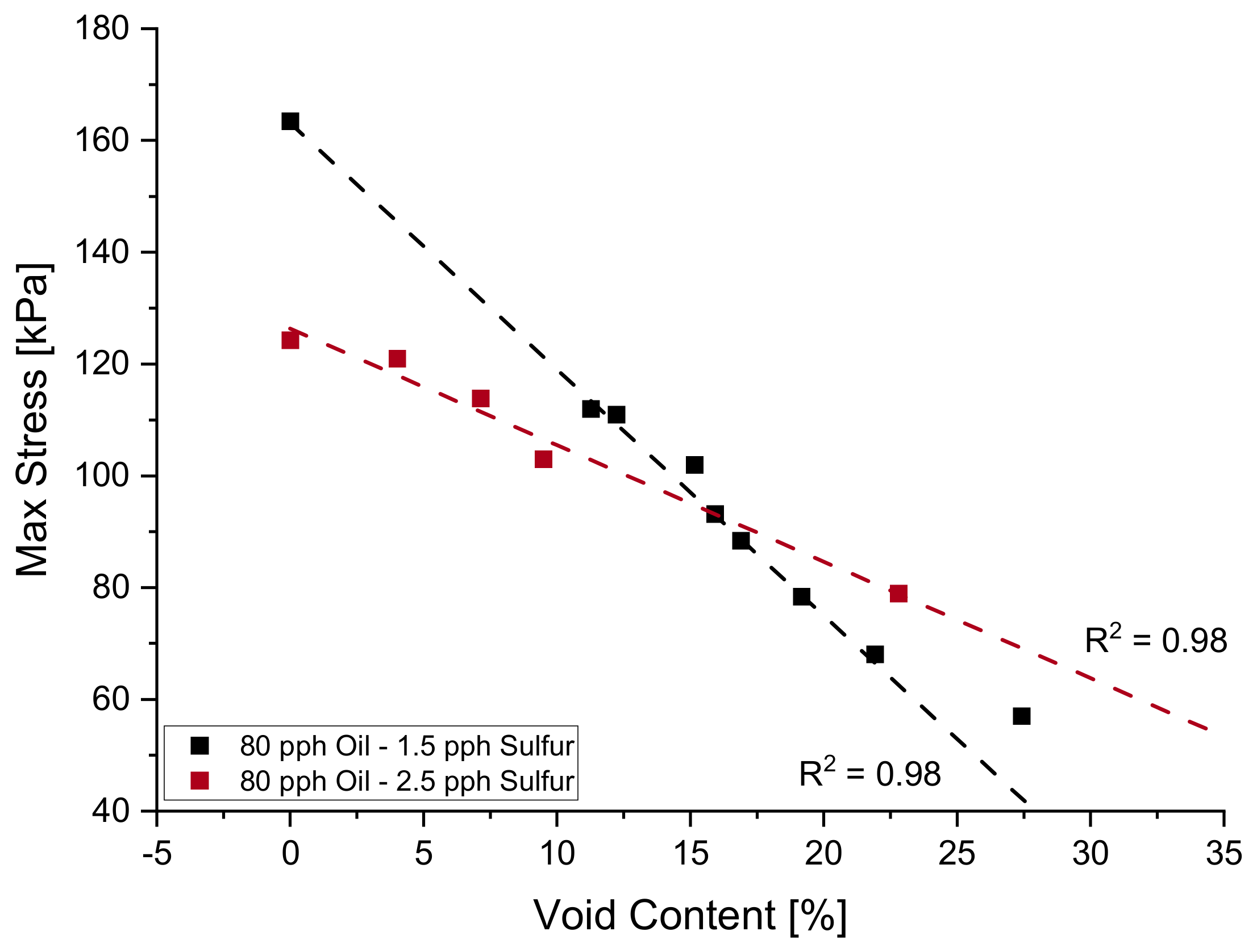



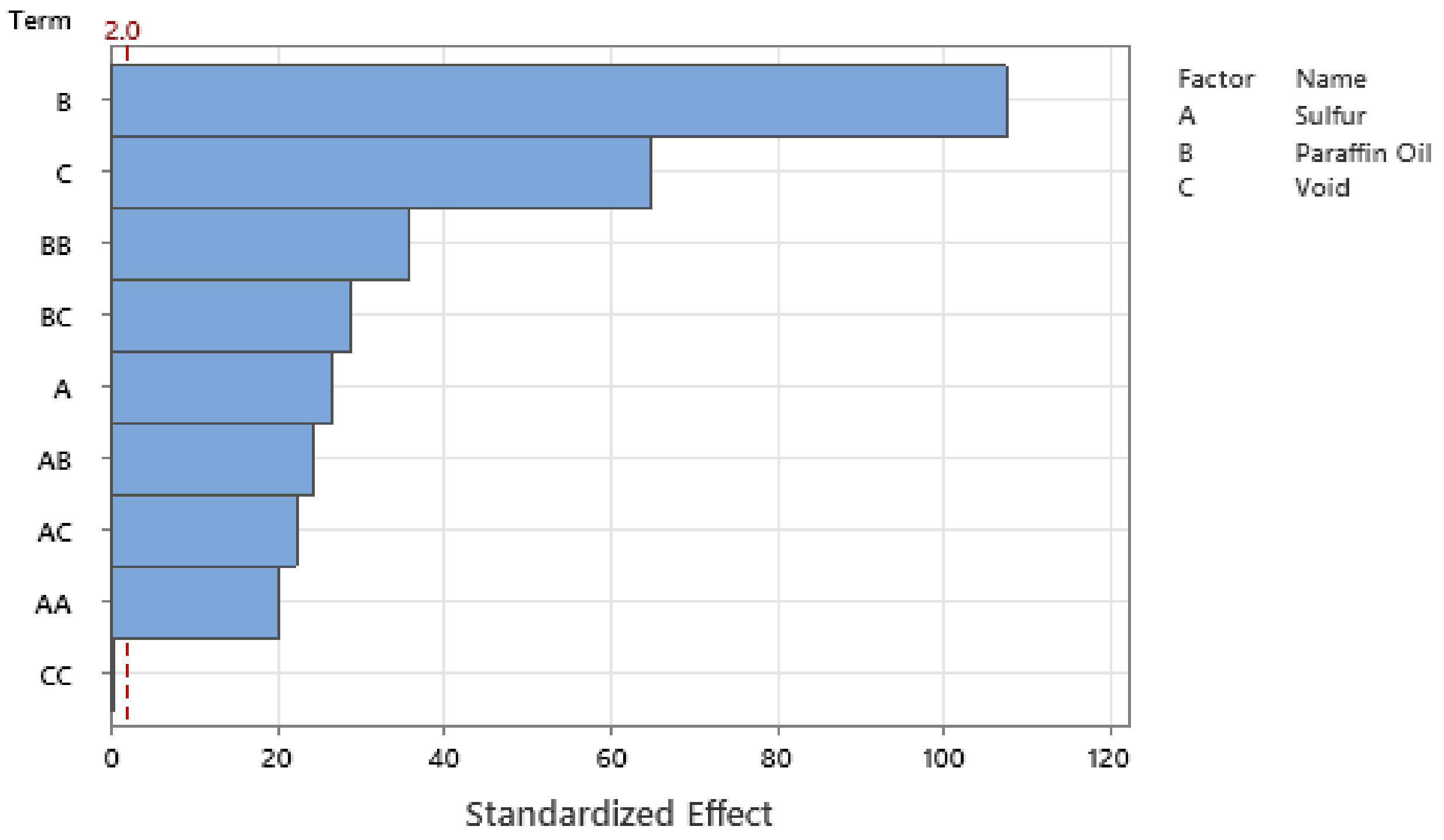
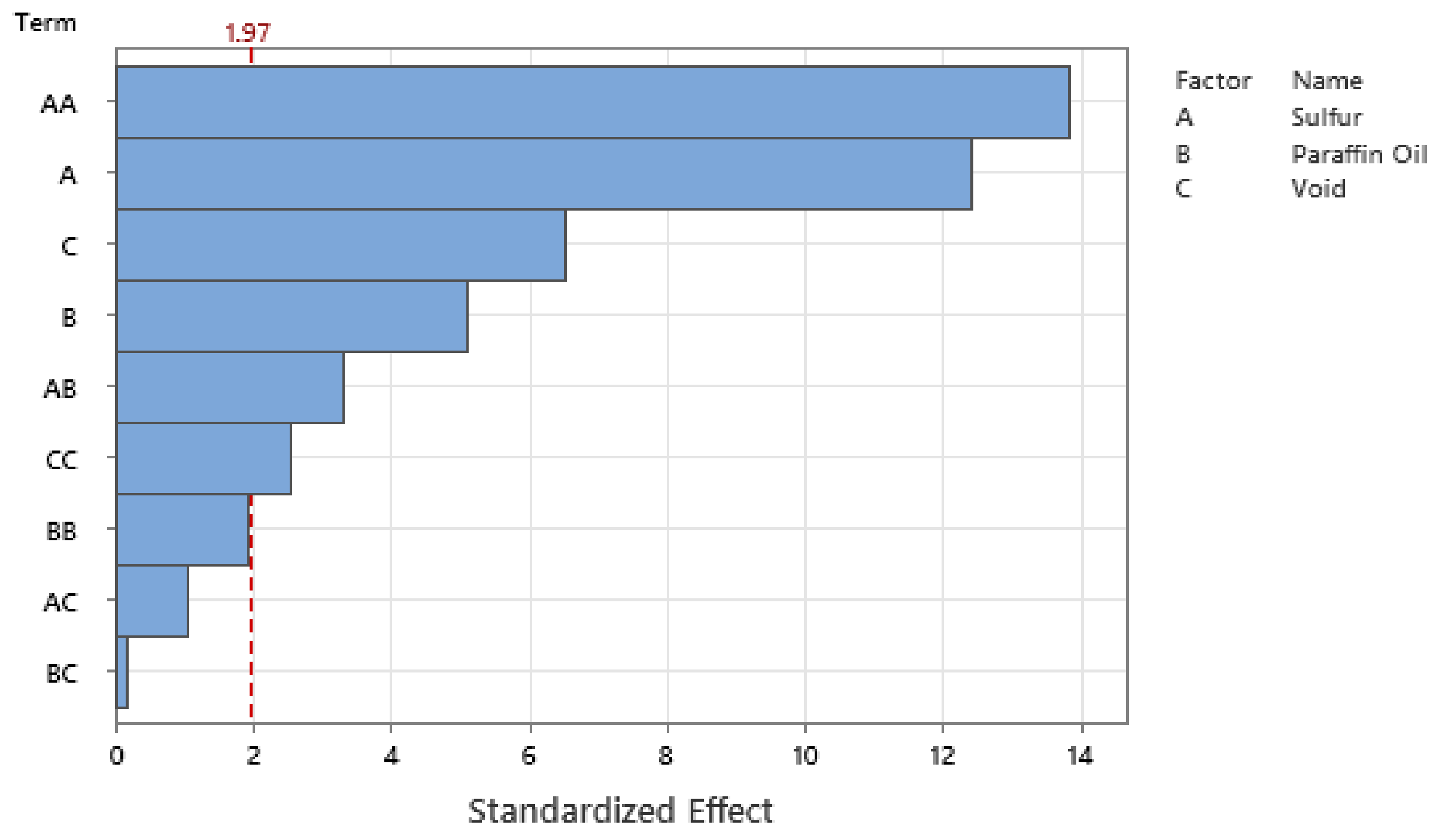

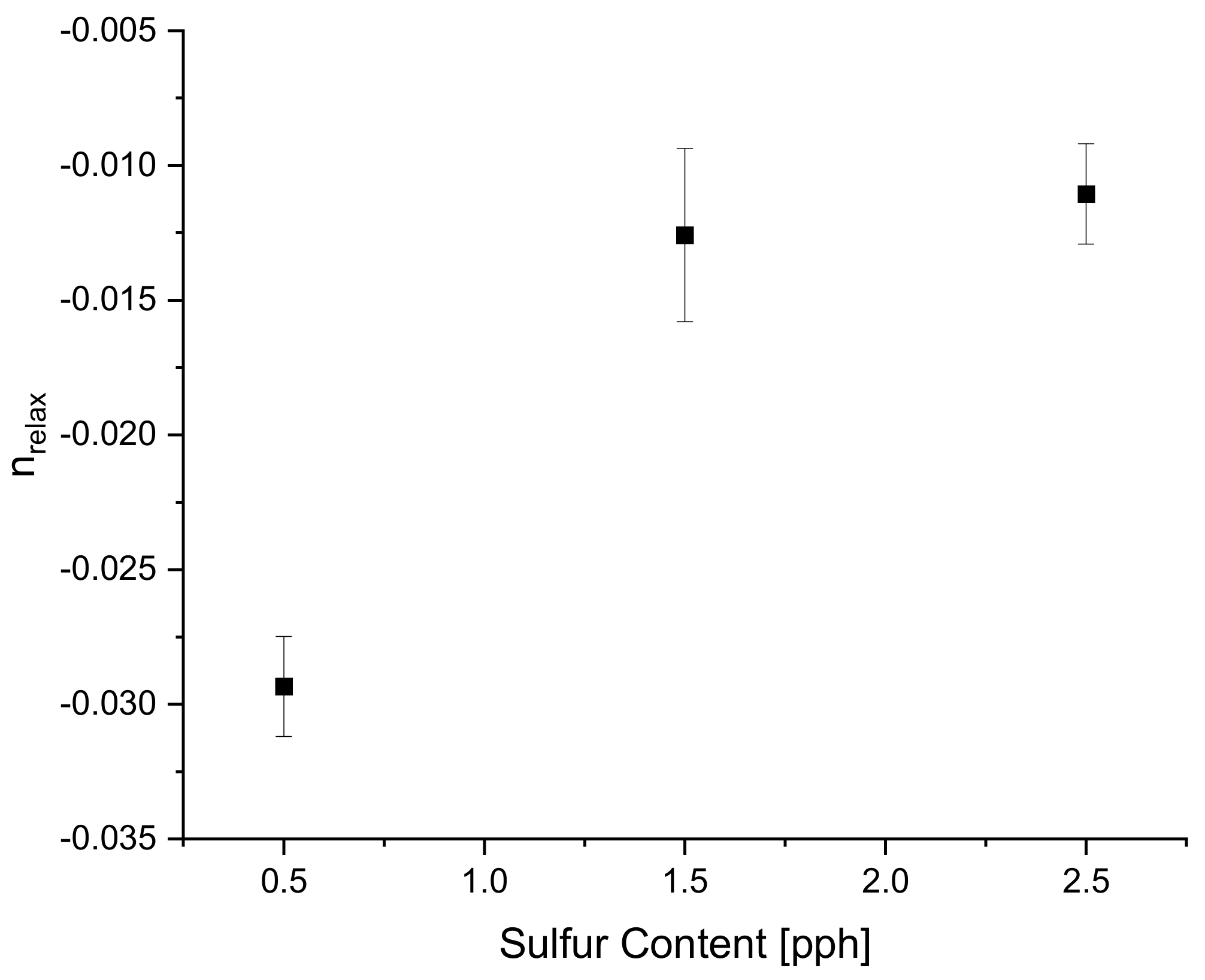
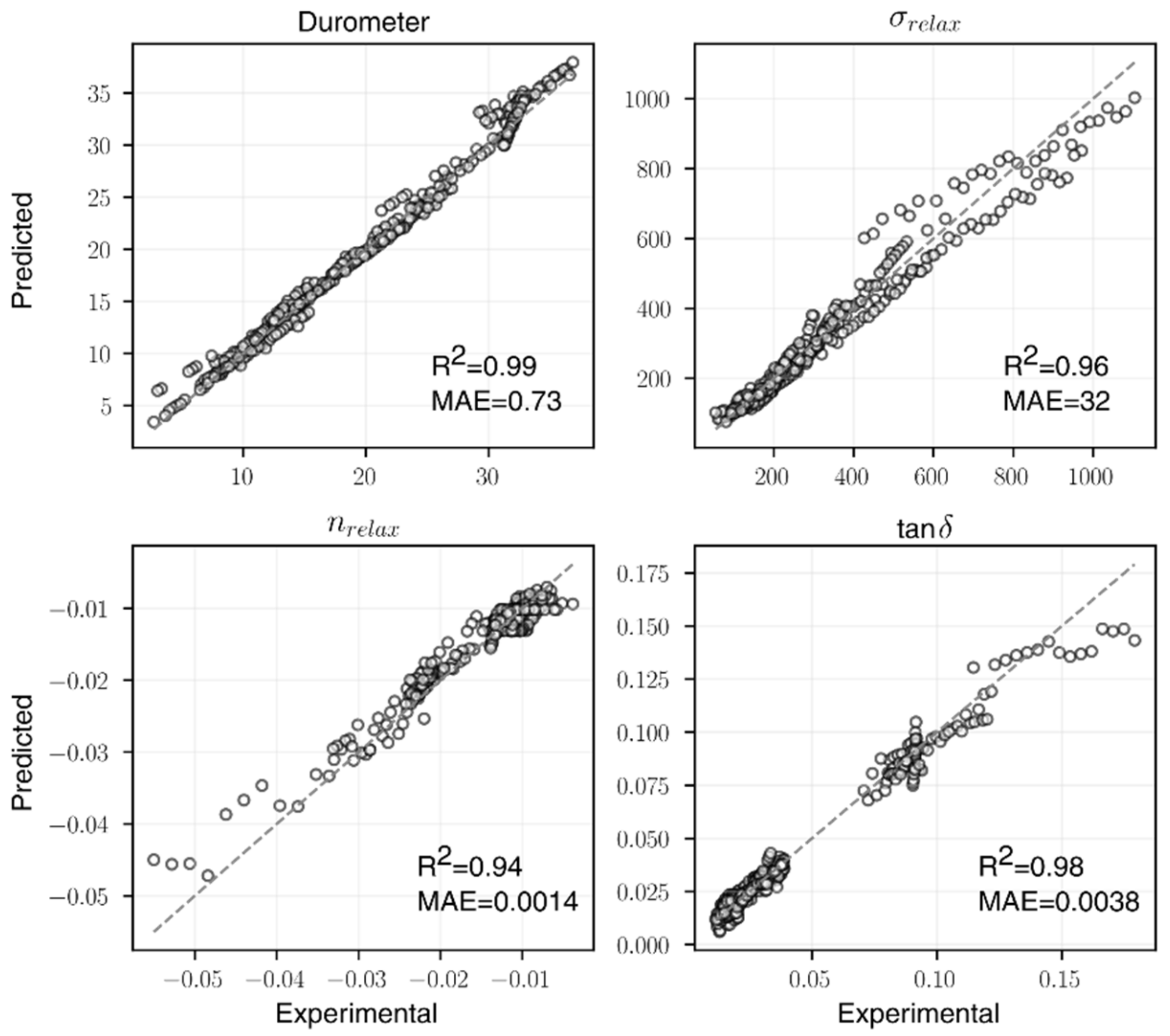


| Material | Provider | Purpose |
|---|---|---|
| Raw Natural Rubber | SOAN Laboratories | Raw Material |
| Sulfur | Fisher Scientific | Cross-linking Agent |
| Sodium Bicarbonate | Sigma-Aldrich | Foaming Agent |
| Stearic Acid | Fisher Scientific | Activator |
| Paraffin Oil | Fisher Scientific | Plasticizer |
| TMTD | Fisher Scientific | Accelerator |
| Zinc Oxide | Fisher Scientific | Accelerator |
| Blend No. | Sulfur (pph) | Paraffin Oil (pph) | Sodium Bicarbonate (pph) |
|---|---|---|---|
| 1 | 2.5 | 80 | 8 |
| 2 | 2.5 | 50 | 8 |
| 3 | 1.5 | 40 | 8 |
| 4 | 1.5 | 80 | 8 |
| 5 | 1.5 | 20 | 8 |
| 6 | 0.5 | 20 | 8 |
| 7 | 0.5 | 0 | 8 |
| 8 | 2.5 | 0 | 8 |
| 9 | 4 | 0 | 8 |
| 10 * | 0.6 | 39 | 8 |
| 11 * | 0.3 | 59 | 8 |
| Variable | Symbol |
|---|---|
| Voltage [kV] | 75 |
| 100 | |
| Integration Time [ms] | 1000 |
| Gain [-] | 8 |
| Number of Projections [-] | 1000 |
| m] | 4 |
| Response Variable | Model Equation | |||
|---|---|---|---|---|
| Durometer [Shore A] | 0.9689 | 0.9680 | 0.9667 | |
| [kPa] | 0.9906 | 0.9903 | 0.9900 | |
| [-] | 0.7533 | 0.7463 | 0.7367 | |
| [-] | 0.8748 | 0.8712 | 0.8660 |
| Target Material Property | Number of Hidden Layers | Number of Neurons in the Hidden Layer | Learning Rate | Number of Learnable Parameters in the Model | 5-Fold CV | 5-Fold CV |
|---|---|---|---|---|---|---|
| Durometer | 1 | 64 | 0.01 | 321 | 0.99 | 0.91 |
| 2 | 16.16 | 0.01 | 353 | 0.96 | 0.90 | |
| 2 | 16.16 | 0.01 | 353 | 0.94 | 0.48 | |
| 1 | 32 | 0.003 | 161 | 0.98 | 0.67 |
| Modeling Method | Prediction Results |
|---|---|
| Target Properties | : 90 : −0.0527 : 0.066 |
| RSM | Sulfur: 0.65 Paraffin: 69.5 Void: 30.0 |
| RSM-predicted Properties | Durometer: 0.45 : 90.26 : −0.02875 : 0.0982 |
| ANN | Sulfur: 0.55 Paraffin: 54 Void: 17 |
| ANN-predicted Properties | Durometer: 5.612 : 82.45 : −0.0399 : 0.113 |
| GPR | Sulfur: 0.55 Paraffin: 57 Void: 10 |
| GPR-predicted Properties | Durometer: 6.187 : 111.78 : −0.0347 : 0.114 |
| Target Material Property | ||||
|---|---|---|---|---|
| Durometer | 0.91 | 0.97 | 0.99 | 1.00 |
| 0.90 | 0.99 | 0.96 | 1.00 | |
| 0.48 | 0.75 | 0.94 | 1.00 | |
| 0.67 | 0.87 | 0.98 | 1.00 |
Publisher’s Note: MDPI stays neutral with regard to jurisdictional claims in published maps and institutional affiliations. |
© 2022 by the authors. Licensee MDPI, Basel, Switzerland. This article is an open access article distributed under the terms and conditions of the Creative Commons Attribution (CC BY) license (https://creativecommons.org/licenses/by/4.0/).
Share and Cite
Román, A.J.; Qin, S.; Rodríguez, J.C.; González, L.D.; Zavala, V.M.; Osswald, T.A. Natural Rubber Blend Optimization via Data-Driven Modeling: The Implementation for Reverse Engineering. Polymers 2022, 14, 2262. https://doi.org/10.3390/polym14112262
Román AJ, Qin S, Rodríguez JC, González LD, Zavala VM, Osswald TA. Natural Rubber Blend Optimization via Data-Driven Modeling: The Implementation for Reverse Engineering. Polymers. 2022; 14(11):2262. https://doi.org/10.3390/polym14112262
Chicago/Turabian StyleRomán, Allen Jonathan, Shiyi Qin, Julio C. Rodríguez, Leonardo D. González, Victor M. Zavala, and Tim A. Osswald. 2022. "Natural Rubber Blend Optimization via Data-Driven Modeling: The Implementation for Reverse Engineering" Polymers 14, no. 11: 2262. https://doi.org/10.3390/polym14112262
APA StyleRomán, A. J., Qin, S., Rodríguez, J. C., González, L. D., Zavala, V. M., & Osswald, T. A. (2022). Natural Rubber Blend Optimization via Data-Driven Modeling: The Implementation for Reverse Engineering. Polymers, 14(11), 2262. https://doi.org/10.3390/polym14112262








